Yuhong Cao
GRATE: a Graph transformer-based deep Reinforcement learning Approach for Time-efficient autonomous robot Exploration
Sep 16, 2025Abstract:Autonomous robot exploration (ARE) is the process of a robot autonomously navigating and mapping an unknown environment. Recent Reinforcement Learning (RL)-based approaches typically formulate ARE as a sequential decision-making problem defined on a collision-free informative graph. However, these methods often demonstrate limited reasoning ability over graph-structured data. Moreover, due to the insufficient consideration of robot motion, the resulting RL policies are generally optimized to minimize travel distance, while neglecting time efficiency. To overcome these limitations, we propose GRATE, a Deep Reinforcement Learning (DRL)-based approach that leverages a Graph Transformer to effectively capture both local structure patterns and global contextual dependencies of the informative graph, thereby enhancing the model's reasoning capability across the entire environment. In addition, we deploy a Kalman filter to smooth the waypoint outputs, ensuring that the resulting path is kinodynamically feasible for the robot to follow. Experimental results demonstrate that our method exhibits better exploration efficiency (up to 21.5% in distance and 21.3% in time to complete exploration) than state-of-the-art conventional and learning-based baselines in various simulation benchmarks. We also validate our planner in real-world scenarios.
Neural Algorithmic Reasoners informed Large Language Model for Multi-Agent Path Finding
Aug 25, 2025Abstract:The development and application of large language models (LLM) have demonstrated that foundational models can be utilized to solve a wide array of tasks. However, their performance in multi-agent path finding (MAPF) tasks has been less than satisfactory, with only a few studies exploring this area. MAPF is a complex problem requiring both planning and multi-agent coordination. To improve the performance of LLM in MAPF tasks, we propose a novel framework, LLM-NAR, which leverages neural algorithmic reasoners (NAR) to inform LLM for MAPF. LLM-NAR consists of three key components: an LLM for MAPF, a pre-trained graph neural network-based NAR, and a cross-attention mechanism. This is the first work to propose using a neural algorithmic reasoner to integrate GNNs with the map information for MAPF, thereby guiding LLM to achieve superior performance. LLM-NAR can be easily adapted to various LLM models. Both simulation and real-world experiments demonstrate that our method significantly outperforms existing LLM-based approaches in solving MAPF problems.
Attention-based Learning for 3D Informative Path Planning
Jun 10, 2025Abstract:In this work, we propose an attention-based deep reinforcement learning approach to address the adaptive informative path planning (IPP) problem in 3D space, where an aerial robot equipped with a downward-facing sensor must dynamically adjust its 3D position to balance sensing footprint and accuracy, and finally obtain a high-quality belief of an underlying field of interest over a given domain (e.g., presence of specific plants, hazardous gas, geological structures, etc.). In adaptive IPP tasks, the agent is tasked with maximizing information collected under time/distance constraints, continuously adapting its path based on newly acquired sensor data. To this end, we leverage attention mechanisms for their strong ability to capture global spatial dependencies across large action spaces, allowing the agent to learn an implicit estimation of environmental transitions. Our model builds a contextual belief representation over the entire domain, guiding sequential movement decisions that optimize both short- and long-term search objectives. Comparative evaluations against state-of-the-art planners demonstrate that our approach significantly reduces environmental uncertainty within constrained budgets, thus allowing the agent to effectively balance exploration and exploitation. We further show our model generalizes well to environments of varying sizes, highlighting its potential for many real-world applications.
Search-TTA: A Multimodal Test-Time Adaptation Framework for Visual Search in the Wild
May 16, 2025Abstract:To perform autonomous visual search for environmental monitoring, a robot may leverage satellite imagery as a prior map. This can help inform coarse, high-level search and exploration strategies, even when such images lack sufficient resolution to allow fine-grained, explicit visual recognition of targets. However, there are some challenges to overcome with using satellite images to direct visual search. For one, targets that are unseen in satellite images are underrepresented (compared to ground images) in most existing datasets, and thus vision models trained on these datasets fail to reason effectively based on indirect visual cues. Furthermore, approaches which leverage large Vision Language Models (VLMs) for generalization may yield inaccurate outputs due to hallucination, leading to inefficient search. To address these challenges, we introduce Search-TTA, a multimodal test-time adaptation framework that can accept text and/or image input. First, we pretrain a remote sensing image encoder to align with CLIP's visual encoder to output probability distributions of target presence used for visual search. Second, our framework dynamically refines CLIP's predictions during search using a test-time adaptation mechanism. Through a feedback loop inspired by Spatial Poisson Point Processes, gradient updates (weighted by uncertainty) are used to correct (potentially inaccurate) predictions and improve search performance. To validate Search-TTA's performance, we curate a visual search dataset based on internet-scale ecological data. We find that Search-TTA improves planner performance by up to 9.7%, particularly in cases with poor initial CLIP predictions. It also achieves comparable performance to state-of-the-art VLMs. Finally, we deploy Search-TTA on a real UAV via hardware-in-the-loop testing, by simulating its operation within a large-scale simulation that provides onboard sensing.
APEX: Action Priors Enable Efficient Exploration for Skill Imitation on Articulated Robots
May 15, 2025Abstract:Learning by imitation provides an effective way for robots to develop well-regulated complex behaviors and directly benefit from natural demonstrations. State-of-the-art imitation learning (IL) approaches typically leverage Adversarial Motion Priors (AMP), which, despite their impressive results, suffer from two key limitations. They are prone to mode collapse, which often leads to overfitting to the simulation environment and thus increased sim-to-real gap, and they struggle to learn diverse behaviors effectively. To overcome these limitations, we introduce APEX (Action Priors enable Efficient eXploration): a simple yet versatile imitation learning framework that integrates demonstrations directly into reinforcement learning (RL), maintaining high exploration while grounding behavior with expert-informed priors. We achieve this through a combination of decaying action priors, which initially bias exploration toward expert demonstrations but gradually allow the policy to explore independently. This is complemented by a multi-critic RL framework that effectively balances stylistic consistency with task performance. Our approach achieves sample-efficient imitation learning and enables the acquisition of diverse skills within a single policy. APEX generalizes to varying velocities and preserves reference-like styles across complex tasks such as navigating rough terrain and climbing stairs, utilizing only flat-terrain kinematic motion data as a prior. We validate our framework through extensive hardware experiments on the Unitree Go2 quadruped. There, APEX yields diverse and agile locomotion gaits, inherent gait transitions, and the highest reported speed for the platform to the best of our knowledge (peak velocity of ~3.3 m/s on hardware). Our results establish APEX as a compelling alternative to existing IL methods, offering better efficiency, adaptability, and real-world performance.
HELM: Human-Preferred Exploration with Language Models
Mar 10, 2025
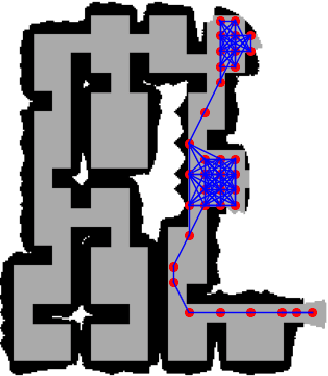
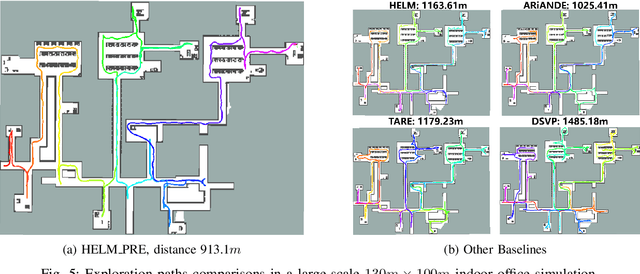
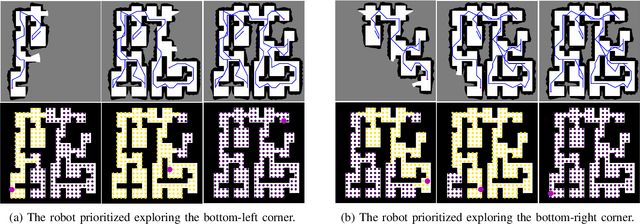
Abstract:In autonomous exploration tasks, robots are required to explore and map unknown environments while efficiently planning in dynamic and uncertain conditions. Given the significant variability of environments, human operators often have specific preference requirements for exploration, such as prioritizing certain areas or optimizing for different aspects of efficiency. However, existing methods struggle to accommodate these human preferences adaptively, often requiring extensive parameter tuning or network retraining. With the recent advancements in Large Language Models (LLMs), which have been widely applied to text-based planning and complex reasoning, their potential for enhancing autonomous exploration is becoming increasingly promising. Motivated by this, we propose an LLM-based human-preferred exploration framework that seamlessly integrates a mobile robot system with LLMs. By leveraging the reasoning and adaptability of LLMs, our approach enables intuitive and flexible preference control through natural language while maintaining a task success rate comparable to state-of-the-art traditional methods. Experimental results demonstrate that our framework effectively bridges the gap between human intent and policy preference in autonomous exploration, offering a more user-friendly and adaptable solution for real-world robotic applications.
SATA: Safe and Adaptive Torque-Based Locomotion Policies Inspired by Animal Learning
Feb 18, 2025Abstract:Despite recent advances in learning-based controllers for legged robots, deployments in human-centric environments remain limited by safety concerns. Most of these approaches use position-based control, where policies output target joint angles that must be processed by a low-level controller (e.g., PD or impedance controllers) to compute joint torques. Although impressive results have been achieved in controlled real-world scenarios, these methods often struggle with compliance and adaptability when encountering environments or disturbances unseen during training, potentially resulting in extreme or unsafe behaviors. Inspired by how animals achieve smooth and adaptive movements by controlling muscle extension and contraction, torque-based policies offer a promising alternative by enabling precise and direct control of the actuators in torque space. In principle, this approach facilitates more effective interactions with the environment, resulting in safer and more adaptable behaviors. However, challenges such as a highly nonlinear state space and inefficient exploration during training have hindered their broader adoption. To address these limitations, we propose SATA, a bio-inspired framework that mimics key biomechanical principles and adaptive learning mechanisms observed in animal locomotion. Our approach effectively addresses the inherent challenges of learning torque-based policies by significantly improving early-stage exploration, leading to high-performance final policies. Remarkably, our method achieves zero-shot sim-to-real transfer. Our experimental results indicate that SATA demonstrates remarkable compliance and safety, even in challenging environments such as soft/slippery terrain or narrow passages, and under significant external disturbances, highlighting its potential for practical deployments in human-centric and safety-critical scenarios.
SIGMA: Sheaf-Informed Geometric Multi-Agent Pathfinding
Feb 10, 2025Abstract:The Multi-Agent Path Finding (MAPF) problem aims to determine the shortest and collision-free paths for multiple agents in a known, potentially obstacle-ridden environment. It is the core challenge for robotic deployments in large-scale logistics and transportation. Decentralized learning-based approaches have shown great potential for addressing the MAPF problems, offering more reactive and scalable solutions. However, existing learning-based MAPF methods usually rely on agents making decisions based on a limited field of view (FOV), resulting in short-sighted policies and inefficient cooperation in complex scenarios. There, a critical challenge is to achieve consensus on potential movements between agents based on limited observations and communications. To tackle this challenge, we introduce a new framework that applies sheaf theory to decentralized deep reinforcement learning, enabling agents to learn geometric cross-dependencies between each other through local consensus and utilize them for tightly cooperative decision-making. In particular, sheaf theory provides a mathematical proof of conditions for achieving global consensus through local observation. Inspired by this, we incorporate a neural network to approximately model the consensus in latent space based on sheaf theory and train it through self-supervised learning. During the task, in addition to normal features for MAPF as in previous works, each agent distributedly reasons about a learned consensus feature, leading to efficient cooperation on pathfinding and collision avoidance. As a result, our proposed method demonstrates significant improvements over state-of-the-art learning-based MAPF planners, especially in relatively large and complex scenarios, demonstrating its superiority over baselines in various simulations and real-world robot experiments.
DARE: Diffusion Policy for Autonomous Robot Exploration
Oct 22, 2024



Abstract:Autonomous robot exploration requires a robot to efficiently explore and map unknown environments. Compared to conventional methods that can only optimize paths based on the current robot belief, learning-based methods show the potential to achieve improved performance by drawing on past experiences to reason about unknown areas. In this paper, we propose DARE, a novel generative approach that leverages diffusion models trained on expert demonstrations, which can explicitly generate an exploration path through one-time inference. We build DARE upon an attention-based encoder and a diffusion policy model, and introduce ground truth optimal demonstrations for training to learn better patterns for exploration. The trained planner can reason about the partial belief to recognize the potential structure in unknown areas and consider these areas during path planning. Our experiments demonstrate that DARE achieves on-par performance with both conventional and learning-based state-of-the-art exploration planners, as well as good generalizability in both simulations and real-life scenarios.
IR2: Implicit Rendezvous for Robotic Exploration Teams under Sparse Intermittent Connectivity
Sep 07, 2024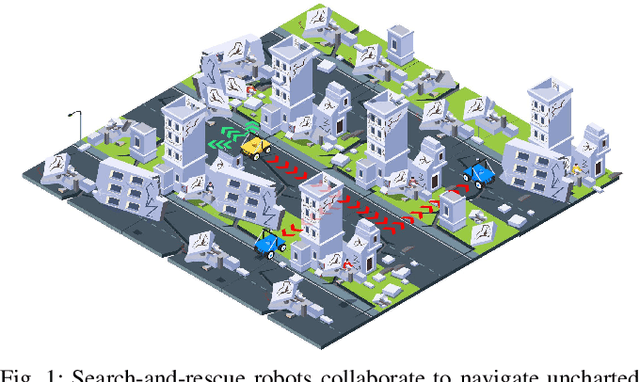


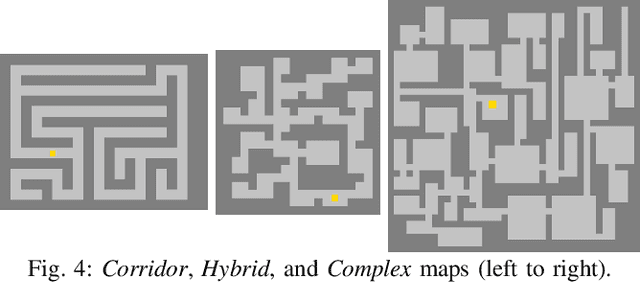
Abstract:Information sharing is critical in time-sensitive and realistic multi-robot exploration, especially for smaller robotic teams in large-scale environments where connectivity may be sparse and intermittent. Existing methods often overlook such communication constraints by assuming unrealistic global connectivity. Other works account for communication constraints (by maintaining close proximity or line of sight during information exchange), but are often inefficient. For instance, preplanned rendezvous approaches typically involve unnecessary detours resulting from poorly timed rendezvous, while pursuit-based approaches often result in short-sighted decisions due to their greedy nature. We present IR2, a deep reinforcement learning approach to information sharing for multi-robot exploration. Leveraging attention-based neural networks trained via reinforcement and curriculum learning, IR2 allows robots to effectively reason about the longer-term trade-offs between disconnecting for solo exploration and reconnecting for information sharing. In addition, we propose a hierarchical graph formulation to maintain a sparse yet informative graph, enabling our approach to scale to large-scale environments. We present simulation results in three large-scale Gazebo environments, which show that our approach yields 6.6-34.1% shorter exploration paths and significantly improved mapped area consistency among robots when compared to state-of-the-art baselines. Our simulation training and testing code is available at https://github.com/marmotlab/IR2.
 Add to Chrome
Add to Chrome Add to Firefox
Add to Firefox Add to Edge
Add to Edge